Ecommerce Link Building
Join the 1,000+ brands that trust us for their link building.
Link building is the process of generating external links from other websites that link to yours. It is one of the most important aspects of SEO. Ecommerce websites depend on backlinks to attract people and stay successful.
Although most site owners are familiar with building internal links into their websites through on-page optimization, many struggle with off-page link building strategies because it’s harder, more costly, and not always within their control or expertise to get links.
Websites with strong link profiles perform well in the SERPs, generate traffic, reach out to target audiences, and make money. This is why link building for ecommerce is so important.
This article is going to discuss how to use various ecommerce link building tactics to develop a quality link profile for your ecommerce site.
Why you want links for your ecommerce site
You want to generate revenue, right? Revenue is how ecommerce sites stay afloat. Your site is no different. It will need to generate revenue through traffic, referrals, trust, visibility in the SERPs, and links.
Your links are important because they signal a vote of confidence in your ecommerce site. They pass on trust and critical ranking factors like authority, relevance, and power from authoritative sites to yours.
Most of the crucial factors that determine the success of an ecommerce site, like ranking and traffic, depend on backlinks to perform well. External links are used to refer potential customers to your site and establish trust in search engines.
It’s very important to get people to visit your site and increase revenue by improving your ranking and visibility in the SERPs. High quality links play a big role in ranking and the most successful ecommerce sites rank well for their respective markets because they build quality links (over 70% of users click through on the first page of search results).
Local lead gen is also a highly effective marketing strategy for targeting the right individuals online.
The more avenues people have to visit your site the better for your business. You need to promote your products and services, convey valuable information and engage readers with shareable content. Links are the oil that keeps the engine running and the traffic flowing.
By now it should seem obvious that your ecommerce site needs links to survive. But what kind of links should you consider? And how should you go about obtaining them?
You should aim for quality over quantity in most cases. There are numerous types of backlinks you can use depending on your goals. Together these links will comprise your backlink profile.
Although outsourcing backlinks from online marketplaces like Fiverr can be a very tempting strategy to quickly get a lot of cheap links, you really need to make sure you’re aiming for quality over quantity when dealing with your ecommerce site.
First, let’s discuss what makes a quality backlink and then we’ll discuss getting links and link building strategies to create a strong and natural link profile.
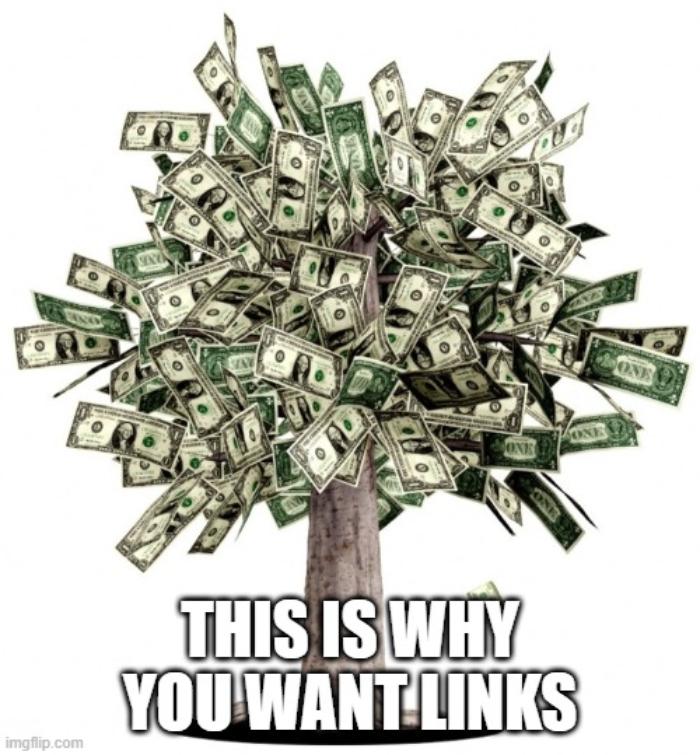
What makes a Quality Backlink?
The most important set of factors for determining the quality of a backlink are known as the Holy Trinity: authority, power, and relevance. A smart link building for ecommerce SEO will get each of these components in varying degrees.
Firstly, a link doesn’t need to get a lot of each factor. For example, a quality link can be high in relevance but low in power and/or authority. Likewise, it can be high in authority and low in power and/or relevance.
The less of one factor a backlink has the more of the other two it should possess.
You would think every high quality backlink would have a lot of each factor, but this is unnatural and shouldn’t be the objective. A backlink will actively improve ranking if it’s strong in at least one of the Holy Trinity factors.
It’s completely normal and even preferred for your backlink profile to be randomly distributed in these factors. This is called link diversity and we will go over this highly important concept in the next section.
Generally speaking, a backlink will increase in quality (and ranking power) if it earns more of these factors based on Google’s analysis.
Let’s continue discussing in detail the factors that make a quality link, starting with each of the factors in the Holy Trinity.
The three most important backlink components for ranking are as follows. These are essential for effective link building strategies.
Authority
Authority is determined by the strength of the backlink profile of the entire domain the link is coming from (its referring domain). Think of all backlinks pointing to all of a website’s pages.
A link with high authority naturally comes from an authoritative website, or a site with a strong backlink profile that earns a lot of trust (from people, referring domains, and Google) and hence receives a wide variety of backlinks from many sites.
Basically, a strong backlink profile is diverse with many quality links. For example, there can be millions of quality backlinks of various types and thousands of referring domains that are associated with a very authoritative site (e.g. WebMD).
Think of authority as the strength of a backlink’s overall referring domain. You may see this metric labeled as Domain Rating (DR) or Domain Authority (DA) depending on which tool you’re using. Authoritative websites are those with high domain authority.
It’s perfectly acceptable for a quality link to be high in authority and relatively low in relevance or power.
You want Google to see other sites pass some of their authority to your product pages because this will only help build trust in your site, get people to your content and improve your business.
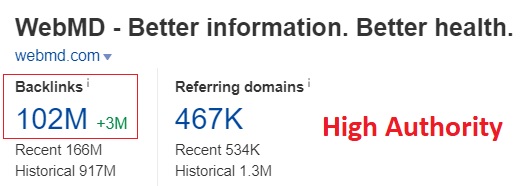
Power
Power is similar to authority except that it refers to the backlink profile of a single page (the page containing your backlink). You may see this metric labeled as URL Rating (UR) or Page Authority (PA) depending on the tool.
A backlink is powerful if, for example, it’s positioned in an article (e.g. guest post) that’s already receiving hundreds of backlinks from other sites. Some of the power from the article’s backlink profile will be transferred to the backlink that’s pointing to your site (called passing link juice).
Power is just a simple measure of the quality of a backlink and another component of the Holy Trinity that you should be aware of. Last but not least is Relevance.
Relevance
Link relevance is very important because it tells Google what your website is about. Relevant backlinks also direct potential buyers to content they may be interested in exploring, such as related products on your ecommerce site. This is why relevance is crucial for niche content marketing.
Google interprets your site’s on-page optimization and content to determine what it’s about (i.e. which keywords it’s optimizing/ranking for) and connects that information to any inbound links pointing to your site’s content.
In other words, Google tries to connect the information from multiple sites (receiver and sender) that are linking to each other in order to determine relevance.
Keep in mind that a non-relevant link is not useless (because there are other factors like authority or power). And don’t worry about not always getting highly relevant links. Some relevance is better than no relevance.
However, it’s important to avoid building a mostly non-relevant link profile.
Other Factors
There is more to assessing the quality of a link than just analyzing how much relevance, power, or authority it has. The Holy Trinity is an excellent gauge to make quick and effective judgments on the value of a link, but there are other things to look at too.
For example, a link can add value if its linking page receives good traffic and rankings. Once again, traffic is beneficial to ecommerce sites because it generates revenue. The more people that visit a linking page the more referral traffic you will receive to your site through the linking page’s backlink.
The clickable text of a link, called the anchor text, is also an important part of backlinks. It’s ideal to use exact match anchors, which is anchor text that matches your keywords. This ties into on-page optimization and the relevance factor of quality links.
There are other types of anchor text you can use like non-keyword anchors (URL, branded, generic variations). This ties into link diversity which will be discussed in the next section.
Another characteristic of a quality link is contextuality. A contextual link is a backlink that is positioned within a paragraph of relevant information. It helps establish relevance. They can also be placed as sidebar links or footer links and still pass link juice, especially if they are on powerful pages with relevant content.
Finally, you want your links to be placed on indexed pages. This is called indexation. It takes time for Google to index pages so always keep track of your links and make sure they eventually get indexed (especially your pushing links). Also, stay away from spammy links like auto-generated links or spun content.
Now you can start link building for your ecommerce site because you know what to identify in a quality link. But one or two quality links aren’t going to cut it. You need as many different types of quality links as you can feasibly get. Quality is better than quantity, but more diverse quality is even better.
This is when you need to understand what makes a good and natural link profile.
Keep Your Link Profile Natural
Together your ecommerce site’s backlinks comprise your link profile. This is basically the footprint that search engine algorithms analyze to reward or penalize you in the rankings. This is why you want to get your link profile as natural as possible.
In SEO, a natural link is a backlink that benefits your ranking and improves authority because Google believes it was earned without your manipulation or intention to influence rankings.
In other words, it was earned organically because someone saw value in your website or content and thought you were worth linking to.
Google periodically refines its algorithms that judge whether a link is natural or not. This makes it harder for SEOs to continually exploit the system or use spammy links.
The good news is that Google doesn’t always know the difference between a natural or unnatural link when safe link building tactics and best practices are used. This means you should try to show Google that you’re using natural links by being smart and keeping your link profile as natural as possible.
One of the best ways to make your link profile natural and safe is through diversification. So let’s take a look at the anatomy of a natural link profile and how to diversify it.
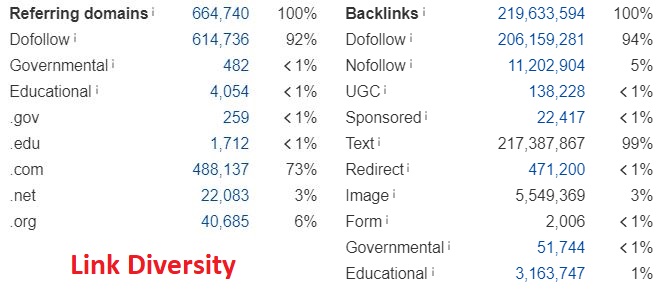
Link Diversity
Link diversity is a strong signal of naturalness because it tells Google that you’re earning various types of links organically and that they don’t fit into some artificial or fake pattern in your link profile.
Google is good at detecting patterns of how and where you’re receiving links. For example, it will know if a bunch of your links are coming from one or two sources (which is a bad sign).
Therefore, a wide variety of links coming from different sources is considered a good natural signal (source diversity). You want to build links that look diverse and random.
Think of diversity and randomness as a shield that prevents algorithms from detecting any predictable patterns in your link profile.
You can achieve link diversity by incorporating many different types of links in an effective link building strategy as long as they make sense for your ecommerce website. This will likely include some of the links discussed in this article.
For example, your link profile should contain a mix of the Holy Trinity and a mix of pillow links and pushing links. Don’t load up too much on any specific type of link such as guest posts or social links.
Anchor diversity is related to link diversity because anchor text is the clickable text of a link. It’s part of on-page optimization and conveys relevance. You shouldn’t overuse exact match anchor text. Instead, use variations of keywords and a mix of branded, generic, or naked anchors.
There are other ways to diversify your link profile such as using social signals or writing reviews. These can be particularly useful for your ecommerce website. You can learn more about these and link diversification by checking out our article on link diversity.
It doesn’t hurt to analyze your competition. You can study the top competitors in your niche with site explorer or backlinks analysis tools to get a clearer picture of what is acceptable and where the boundaries might be in regards to performing well in the SERPs.
Sometimes websites will rely heavily on certain types of backlinks and still rank. This is not the safest strategy and should only be considered by an experienced SEO who routinely monitors her sites.
The best practice for long-term success is to stay diversified as much as possible.
You can further classify the links in your portfolio by whether they were obtained through white hat or grey/black hat techniques. These are umbrella categories that include all links which contribute to link diversity.
We are not saying either category is better or worse than the other. However, we do want to highlight the usefulness of each. The type of hat won’t affect the quality of your link profile when backlinks are applied correctly and intelligently (with safe tactics and best practices). Google only knows what you show it.
We have divided some ideas into both white hat and grey/black hat categories for your reference, so let’s continue.
Link Building Tactics (White Hat)
White hat basically means SEO tactics that improve your rankings while adhering to conditions that are approved by search engines like Google.
These are the safest techniques to use if you’re new to SEO or worried about possibly incurring penalties from algorithms.
Utilize your blog section to create content
This is one of the most important things to do because it allows you to share link-worthy content directly from your website. Link-worthy content (i.e. shareable content) is anything that’s informative, engaging, trendy, or newsworthy.
Text articles, guest posts, videos, or images are some examples of content creation for your blog section.
A blog section is a great way to post articles or share videos about the products and services you’re selling to a target market. It’s your chance to promote your expertise in a field through content creation.
You should market your published articles by engaging industry leaders, social media platforms, and other relevant blog posts that would benefit from sharing your content.
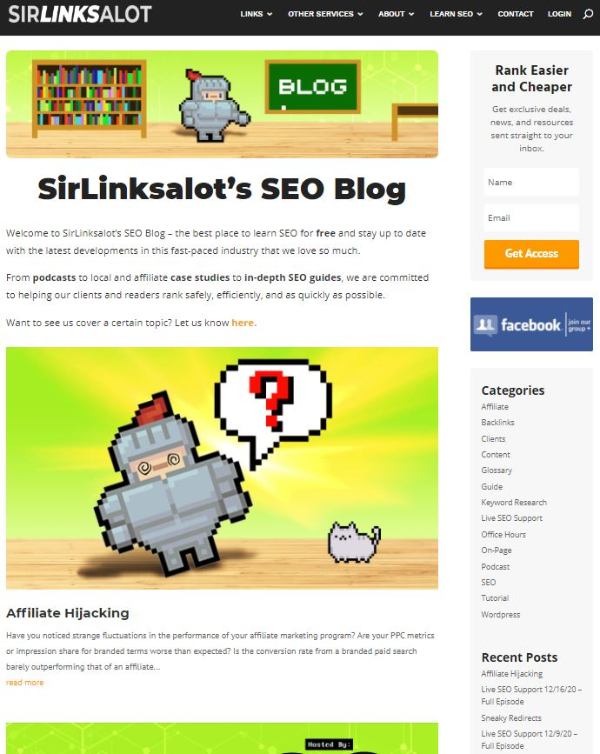
Comment on blogs
Even though blog comments used to be a magnet for spammy self-promotion, there is still SEO value in commenting on a blog post because it’s a natural and free way to build links.
The key to maximizing the potential of a blog comment is to post relevant and useful information on authoritative websites that allow “dofollow” comments.
Only leave a comment if it’s relevant and will add value to users. Keyword stuffing, excessive anchor text, and self-promotion will likely be frowned upon.
Editorial Links
Editorial links are authority links associated with news publishing websites or trustworthy sites with very high domain authority.
You obtain editorial links by writing relevant, high-quality content. But it’s more complicated than that. You can learn more about editorial links: Buy Editorial Links.
Answer questions with FAQs, manuals, and helpful resources
People use the internet to learn and ask questions. That’s why users find resources like FAQ, question forums, and how-to manuals so useful.
Information resources like these are particularly useful for products and services in niche markets. You may be marketing technical products that buyers want to learn more about. You can consider writing a glossary/dictionary, PDF technical manuals, or a simple FAQ pertaining to your product.
Search the internet and message forums for the most frequently asked questions and concerns that people have about your product, service, or niche category. Then you can begin publishing comprehensive and efficient information that delivers answers to users in a quick and complete manner.
Posting PDF manuals for uncommon niche products is very helpful to potential buyers.
Your answers or informative content may be linked to and shared online if enough people find them useful and relevant. This is how you can obtain quality natural links and organic traffic to your FAQs or how-to pages.
Don’t forget to link back to your actual product pages from your FAQ once it begins ranking so you can distribute that link juice.
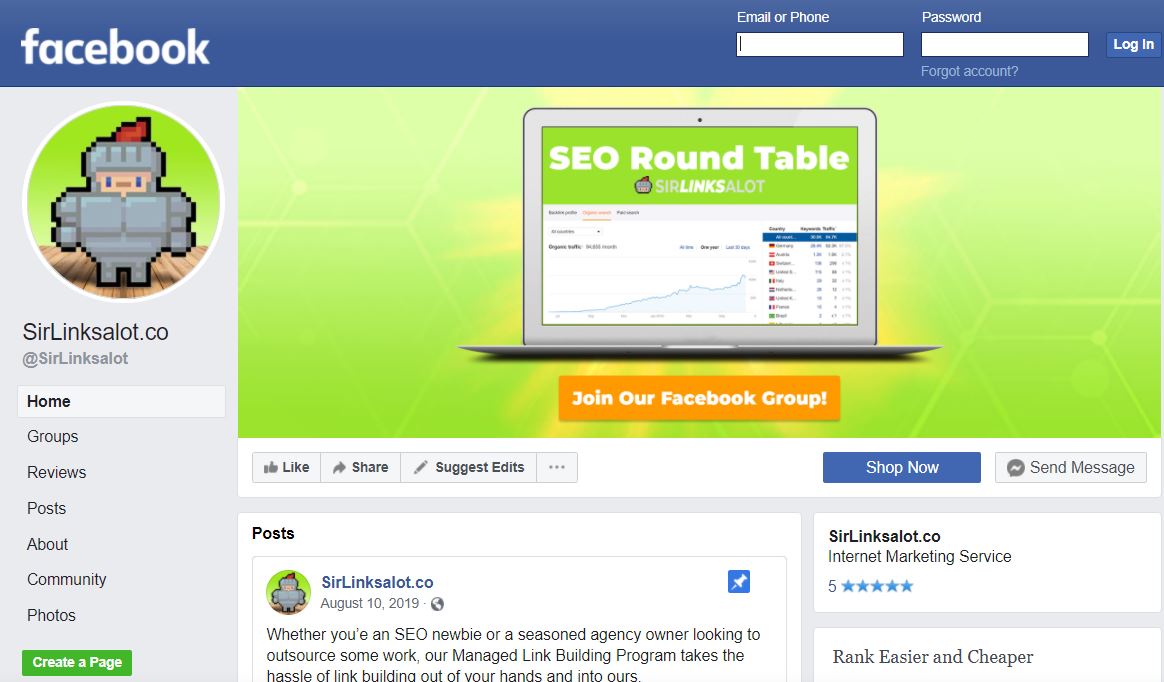
Submit your site to directories, forums, and social profiles
Submitting your website to niche directories, forums, and social networking sites (profile creation) is a great way to gain a reputation and attract a targeted audience.
There are directories and forums for specific industries, local businesses, municipal organizations, products, hobbies, or social activities.
Avoid spammy or untrustworthy directories because these are the types of sites that don’t play by Google’s rules and don’t follow best practices.
These types of links won’t be that powerful but they’ll help diversify your link profile and add relevance and trust to your ecommerce store.
Perform outreach
Outreach marketing is the act of contacting individuals or organizations that may share similar interests with you. For example, you may have business partners if you’re running an ecommerce website.
Customers, retailers, suppliers, sponsorship recipients, or anyone you establish business relationships with may present content marketing opportunities to promote your brand or link back to your website.
Make donations/contributions
You can gain favor from webmasters for contributions to individuals or organizations. Look for anyone that lists their donors with links and get yourself on that list if you’ve made a contribution.
Find unlinked mentions of your brand and broken link build
Your products or ecommerce brand may already be getting noticed online but you’re losing traffic because the mentions aren’t linked to your content (make sure to look for mentions on social media platforms).
This is your chance to grab some quick wins (links to your website) by using automated tools to find online mentions of your products and contacting the webmasters for the inclusion of a link.
Sometimes a link may exist but it’s pointing to a broken or irrelevant page. The process of correcting this issue is called broken link building. It involves searching a website for a link that directs to content that’s unavailable or no longer exists and requesting an alternative link be used instead.
Make memes, infographics, or other shareable content
Images, infographics, videos, or memes are some of the most liked and shared content on the web. One viral infographic can draw you hundreds or thousands of links from social media platforms.
So if you have the ability to create images or post video content then give it a shot. Just don’t forget to get credit for your content wherever it’s used by searching for published images with Google and including links to your product pages.
Purchase a domain to use as a 301
A pretty advanced tactic is to purchase an expired domain to utilize its preexisting backlink profile. However, in most cases, you would want to 301 the domain and have it redirect to your ecommerce site.
Google has stated that 301 redirects don’t penalize your ability to rank, so they are still a valid choice for link building.
It’s important to analyze the backlink profile of the domain you wish to purchase. Make sure it adheres to the principles of a strong and quality link profile as mentioned in this article. You also want the domain and its backlinks to be as relevant as possible to your ecommerce content.
Let’s move on to grey/black hat methods.

Link Building Tactics (Grey/Black Hat)
We believe that grey/black hat tactics are just as effective as white hat tactics, and more so in some cases. Contrary to what some white hat practitioners may claim, Google doesn’t know the difference between black hat or white hat links if those links were obtained by using safe link building techniques and best practices.
With skillful application and sound SEO techniques, a grey or black hat link won’t have a negative effect on quality and will only serve to improve your rankings.
Practically speaking, we don’t like to think in terms of “hat” colors because the quality of the link has to do with the smart application of techniques and not an arbitrary label.
Having said that, here are some of the best grey/black hat tactics you can use in your ecommerce link building strategy.
Buy Backlinks
Purchasing from a third party is an efficient method for building links. There are link vendors who specialize in selling a variety of backlinks, and publishing relevant content, depending on your needs.
High quality links aren’t always expensive. You can acquire quality links at an affordable price. Sometimes mediocre links can have higher prices than you would expect. This is because the prices of links, such as those from guest posts, are influenced by website owners.
Pillow Links
Pillow links provide padding and insulation to your site by diversifying your link profile and adding relevance, trust, and visibility.
Links from blog comments (like forum and directory links) are examples of pillow links. They will contribute relevance and visibility to your ecommerce site but they won’t do much for ranking (unless you’re targeting an ultra low-competition niche).
It’s perfectly natural and recommended to deploy pillow links throughout the lifespan of your website because they will maintain diversity for your link profile.
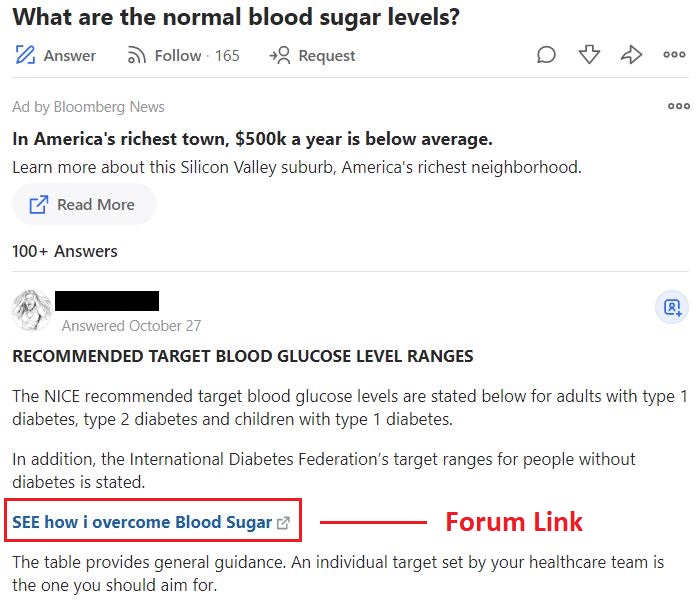
Guest Posts/Niche Edits/PBN Links
These are the powerful companions of pillow links, which we call pushing links, that provide the raw ranking power for your site.
Guest posts, niche edits, and PBN links (described in the next section) are some of the most powerful and popular types of links used by white, grey, and black hat SEO (with guest posts taking the top spot in terms of popularity).
We use these 3 types of links to help push many of our sites into top SERP positions. Your ecommerce site will benefit from them too.
Guest posts are newly published articles on the inner pages of niche sites and content blogs. They can be obtained naturally from powerful sites and provide contextual, niche-relevant backlinks.
Niche edits are very similar to guest posts except they are inserted into preexisting content. This means the articles they are edited into usually have preexisting link profiles. Niche edits benefit from page age (or domain age) and are cheaper than guest posts.
A PBN link is a very different breed of backlink compared to niche edits or guest posts and is probably the most powerful type of link you can build. It takes an experienced SEO to utilize PBN links in an effective way because they aren’t beginner-friendly.
Generally speaking, a PBN link is a contextual and niche-relevant homepage link with a lot of preexisting backlinks pointing to the page the PBN link is positioned on (adding to its power). You should plan to diversify your link profile when using PBN links because it’s unnatural to receive a lot of powerful backlinks that link back to your homepage.
Managed Link Building
Managed link building is an off-page SEO service provided by backlink vendors that specialize in ecommerce link building.
If you have a decent budget and want professionals to do all the link building for you, then consulting with a managed link building service is an excellent way to get the performance you desire out of your ecommerce site.
The pros will serve as consultants and technical specialists who will audit your website, devise a strategic plan based on your goals, build out your link profile and monitor your progress and website health.
Final Thoughts on Ecommerce Linkbuilding
External links have played a major role in determining a domain’s overall authority and ability to rank for specific keywords since the beginning of search engines.
Ecommerce link building is more important now than it’s ever been. Your ecommerce website will depend on building links to get traffic and generate revenue.
Unless you’re selling an extremely innovative or popular product, it’s not going to be easy to rank well in the SERPs and get people to visit your site without understanding what quality backlinks are and how to get them.
Improving your ranking should be one of your main goals. This means focusing on quality before quantity. Authority, power, and relevance are the main factors that will improve the performance of your ecommerce website.
You also need relevant internal links to dynamic content to maintain a healthy bounce rate in check and get customers to stay on your website.
Make sure to create a natural link profile by maintaining link and anchor diversity throughout your content and the lifespan of your website. Be smart, follow best practices, and don’t worry too much about whether you’re using white or black hat tactics to build links.
Contributing Author: Brian Kihneman
 Article by:
Article by:
Nicholas Altimore
Hey I'm Nick, the Founder/Director here at SirLinksalot. I have a passion for building online businesses and taking websites to the next level with the help of my amazing link building team.
 Questions or Comments?
Questions or Comments?
We are active in our Facebook Group seven days a week and would love to hear from you. Ask us questions, learn from other group members, and share your knowledge.
Related Posts
Ready To Start Building Your Rankings?
Your link building journey to the top of Google starts today!
Apply for Managed Link Building to get a free analysis and game plan, or order backlinks a la carte.
Link building services that work.


